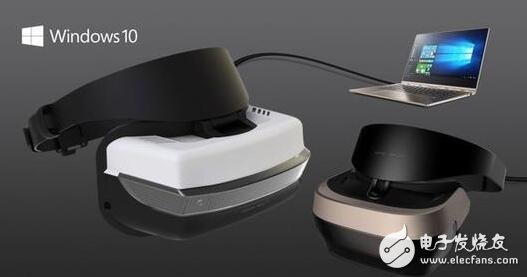On December 20th, Microsoft released several major new products such as Surface Studio, Surface Dial, and Surface Book at the new product launch conference on October 26. In addition, Microsoft also released VR headset. .
According to Tom's hardware, Microsoft has released more information about its affordable PC VR headers.

According to the information, the head is divided into high-end and mainstream. The main difference is the refresh rate. The high-end version has a refresh rate of 90 Hz and the mainstream version has a refresh rate of 60 Hz.
The mainstream PC VR headshow has the same resolution as the Rift and Vive, with 1200x1080 pixels per eye, but they will rely on the LCD display instead of the AMOLED screen. At the same time, Microsoft's high-end HMD heads will have a resolution of 1440x1440 pixels per eye, using an OLED screen.
Other differences between the high-end version and the mainstream version include control and audio equipment, as well as wiring requirements.
All of Microsoft's partners will use Microsoft's Inside-Out tracking system. This approach eliminates the need for markers and cameras scattered throughout the room and replaces them with a single camera and inertial sensor within the head display to provide positional data for the indoor VR experience. This "six degrees of freedom" feature typically does not support mobile VR platforms.
Microsoft expects the mainstream PC VR to be worth $299, but has not yet released pricing information for high-end products. Microsoft PC VR Head Show partners will showcase these products at the Consumer Electronics Show in January.

1. Electronic balance and its classification According to the accuracy of electronic balance, it can be divided into the following categories:
1. Ultra-micro electronic balance: The maximum weighing of the ultra-micro balance is 2 to 5g, and its scale division value is less than (maximum) 10-6. For example, Mettler's UMT2 electronic balance belongs to the ultra-micro electronic balance.
2. Microbalance: The weighing of the microbalance is generally 3 to 50g, and its division value is less than the (maximum) weighing 10-5, such as the AT21 electronic balance of Mettler and the S4 electronic balance of Sartoruis.
3. Semi-micro balance: The weighing of semi-micro balance is generally 20 to 100g, and its division value is less than (maximum) 10-5. For example, Mettler's AE50 electronic balance and Sartoruis' M25D electronic balance belong to Such.
4. Constant electronic balance: the maximum weighing of this kind of balance is generally 100 to 200g, and its division value is less than (maximum) weighing 10-5, such as Mettler's AE200 electronic balance and Sartoruis A120S, A200S electronic balance The average is a constant electronic balance.
5. Analytical balance: In fact, electronic analytical balance is a general term for macro balance, semi-micro balance, micro balance and ultra-micro balance.
6. Precision electronic balance: This type of electronic balance is a general term for electronic balances with an accuracy level of â…¡.
Laboratory Scale,Analytical Balance,Precision Balance,Small-range Weighing Scale,Small-range Industrial Weighing.,Electronic Balance,Jewelry Scale
Electronic balance, laboratory scale, small-range weighing scale, jewelry scale, analytical balance, precision balance, small-range industrial weighing.
Ningbo Santwell Imp & Exp Co.,Ltd , https://www.santwell.com